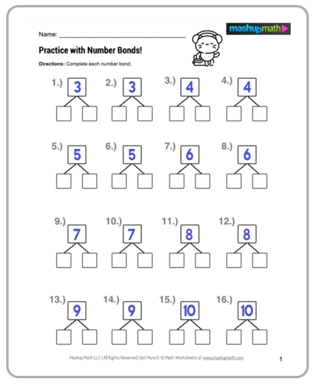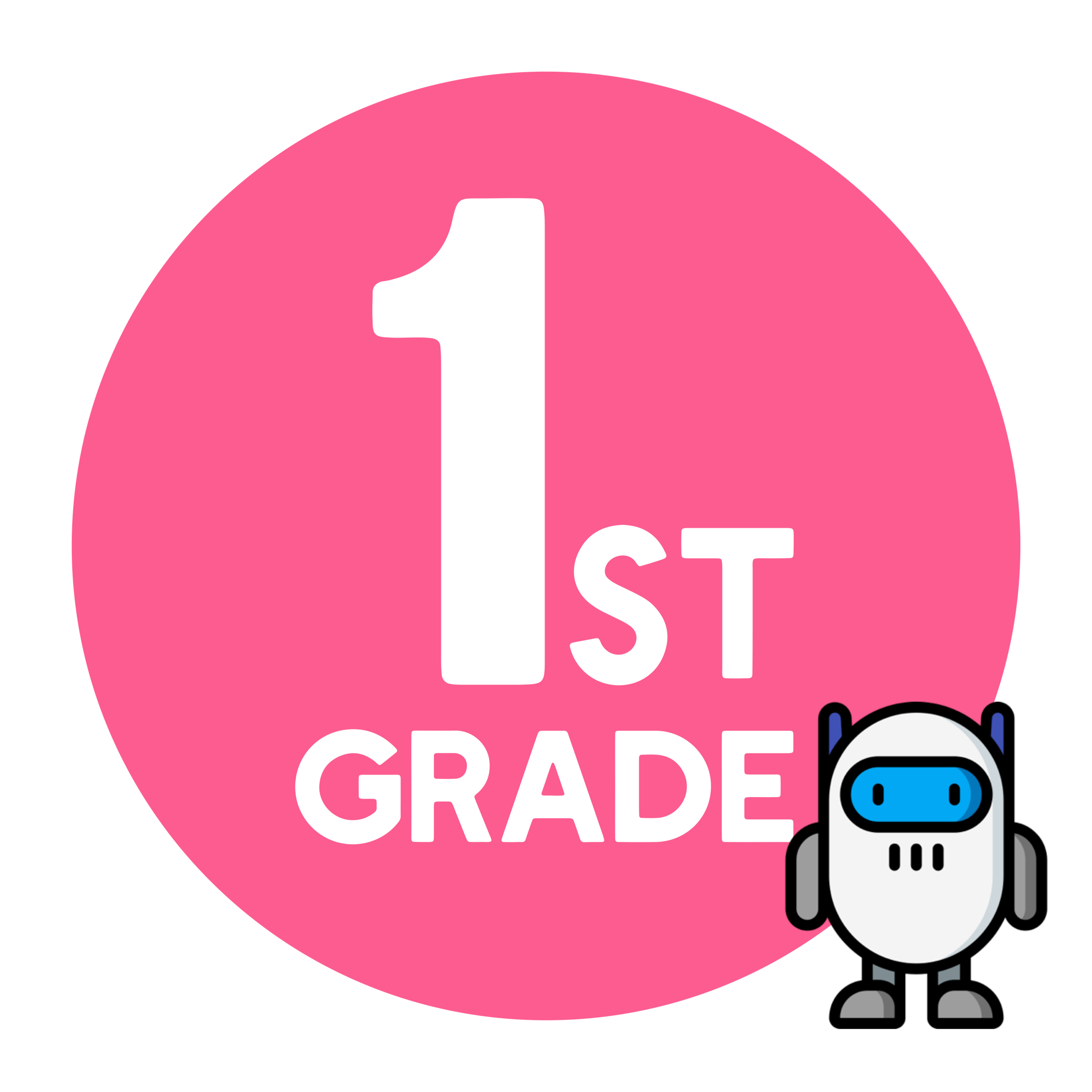


This collection of 1st Grade Math Worksheets are organized by topic and overall skill level. Each worksheet is designed with the needs of 1st grade students in mind, as they are created to be engaging, colorful, and appropriately challenging for a typical first grade student. The math skills and topics below are all key foundational mathematics and problem-solving skills that students will need in order to be successful in higher levels of math in science when they eventually enter middle school and high school, so getting first grade students interested in mathematics early on is incredibly important.
The free sample first grade math worksheets below are unique in that they are not overloaded with repetitive and monotonous practice problems. Instead, they are considerate of a first graders attention span, and they are designed to allow 1st grade students to practice and learn math in ways that are exploratory, engaging, and fun!
If you want to gain access our complete library of 1st grade math worksheets and answer keys, you can sign-up for access to our K-8 math worksheet portal, where you can download ALL of our grade and topic-specific math worksheets.
🛑 Wait! Would you like getting FREE K-8 math activities, lesson resources, worksheets, and puzzles in your inbox every week? 💁♀️

▶️ Writing Numbers: 0 | 1 | 2 | 3 | 4 | 5 | 6 | 7 | 8 | 9 | 10
▶️ Writing Numbers: 11 | 12 | 13 | 14 | 15 | 16 | 17 | 18 | 19 | 20
🔒 Practice writing numbers 8 and 9
🔒 Practice writing numbers 10-13
🔒 Focus on 6 and 7
🔒 Focus on 8, 9, and 10
🔒 Focus on 11
🔒 Matching numbers with words (up to 20)
🔒 (C) Counting numbers 1-10
🔒 (D) Counting numbers 1-10
🔒 Skip counting by 5
🔒 Skip counting by 10
🔒 Skip counting: mixed
🔒 Counting backwards 20-1 A
🔒 Counting backwards 20-1 B
🔒 Practice writing numbers 51-75
🔒 Practice writing numbers 76-100
🔒 Writing numbers as words 31-40
🔒 Writing numbers as words 41-50
🔒 Writing numbers as words 51-60
🔒 Writing numbers as words 81-90
🔒 Writing numbers as words 91-100
🔒 Matching numbers with words 1-150
🔒 Circle a number of objects (to 20)
🔒 Practice with number bonds (mixed)
🔒 Identifying number patterns (up/down: 1-5, 10)
🔒 Identifying number patterns (up/down: 1-5, 10)
🔒 Input and output charts (B)
🔒 Input and output charts (C)
🔒 Reading number lines (B)
🔒 Reading number lines (C)

🔒 Which number/group is smaller?
🔒 Comparing numbers B
🔒 Comparing numbers C
🔒 Comparing numbers using < or >(up to 50)
🔒 Comparing numbers using < or >(up to 100)
🔒 Even or odd? (up to 100)
🔒 Writing ordinal numbers B
🔒 Matching ordinal numbers
🔒 Order numbers from greatest to least (up to 100)
🔒 Order numbers from least to greatest (up to 10)
🔒 Order numbers from least to greatest (up to 50)
🔒 Order numbers from least to greatest (up to 100)

🔒 Base 10 blocks-regrouping (B)
🔒 Counting with base 10 blocks (B)
🔒 Counting with base 10 blocks (C)
🔒Express numbers as 10’s and 1’s (B)
🔒 Express numbers as 10’s and 1’s (C)
🔒 Adding using base 10 blocks (B)
🔒 Adding using base 10 blocks (C)
🔒 Place value: identify tens and ones (B)
🔒 Place value: identify tens and ones (C)
🔒 Combine tens and ones (C)
🔒 Identifying place value: tens and ones (B)
🔒 Identifying place value: tens and ones (C)
🔒 Adding tens and ones (B)
🔒 Adding tens and ones - advanced (B)
🔒 Rounding to the nearest 10 (B)
🔒 Rounding to the nearest 10 (C)

🔒 Measuring lengths in inches (C)
🔒 Measuring lengths in inches (D)
🔒 Measuring lengths in inches (E)
🔒 Measuring lengths in inches (F)
🔒 Measure the object in centimeters (C)
🔒 Which object weighs less?

🔒 Matching coins with values (USD)
🔒 Matching coins with values (CAD)
🔒 Coin Focus: Dime (USD)
🔒 Coin Focus: Quarter (USD)
🔒 Piggy bank: count the coins (USD)
🔒 How much does it cost? (USD) (B)

🔒 Practice with Number Bonds: 10
🔒 Practice with Number Bonds: 11-19
🔒 Practice with Number Bonds: 20
🔒 Add three (single-digit)
🔒 Add using dice
🔒 Simple addition: single-digit (large font) (B)
🔒 Vertical addition to 10 (B)
🔒 Vertical addition to 20 (B)
🔒 Vertical addition to 50 (A)
🔒 Vertical addition to 50 (B)
🔒 Vertical addition to 100 (A)
🔒 Vertical addition to 100 (B)
🔒 Practice adding 9
🔒 Practice adding 10
🔒 Addition: fill in the missing number (up to 20)
🔒 Addition: fill in the missing number (up to 100)
🔒 Adding double-digit numbers (B)
🔒 Adding triple-digit numbers
🔒 Mixed addition and subtraction (2-digit) B
🔒 Mixed addition and subtraction (3-digit)

🔒 Subtract three (single-digit)
🔒 Subtract from 10 (B)
🔒 Simple subtraction: single-digit (large font) (B)
🔒 Vertical subtraction (to 50)
🔒 Vertical subtraction (to 100)
🔒 Subtraction: fill in the missing number (up to 20)
🔒 Subtraction: fill in the missing number (up to 100)
🔒 Subtracting double-digit numbers (B)
🔒 Subtracting triple-digit numbers
🔒 Practice subtracting 9
🔒 Practice subtracting 10
🔒 Subtraction practice: subtracting whole tens
🔒 Mixed addition and subtraction (2-digit) A
🔒 Mixed addition and subtraction (3-digit)

🔒 Counting tally marks (B)
🔒 Drawing tally marks (B)
🔒 Completing tally charts (B)
🔒 Reading bar graphs (B)
🔒 Reading bar graphs (C)
🔒 Making bar graphs (B)
🔒 Making bar graphs (C)
🔒 Analyzing bar graphs (B)
🔒 Analyzing bar graphs (C)

🔒 Dividing shapes into equal parts
🔒 Matching fractions with words B
🔒 Matching fractions with words C
🔒 Writing Fractions B

🔒 Patterns of shapes
🔒 Matching shapes to real-world objects
🔒 Matching similar shapes
🔒 Drawing shapes: rectangles
🔒 Drawing shapes: triangles
🔒 Drawing shapes: diamonds

🔒 Addition word problems (2-digit) B
🔒 Addition word problems (3-digit)
🔒 Subtraction word problems (2-digit) A
🔒 Subtraction word problems (2-digit) B
🔒 Subtraction word problems (2-digit)
🔒 Length word problems (in inches) (B)
🔒 Length word problems (in centimeters) (B)

🔒 Units of time (hours)
🔒 Units of time (days)
🔒 Reading the clock (hours) (large font) (B)
🔒 Units of time: minutes, hours, or days?
🔒 Telling time in whole hours (B)
🔒 Telling time in half hours (B)
🔒 Telling time in quarter hours (B)
🔒 Draw the time on the clock using a digital clock (hours)
🔒 Draw the time on the clock (hours, half hours)
🔒 Elapsed time (B)
🔒 Elapsed time (C)
When you sign up for the Mashup Math Infinite K-8 Worksheet Portal, you will gain access to all of our first grade math worksheets and answer keys all in one convenient place.
The first grade math worksheets shared above were carefully designed to give your 1st grade students a fun and engaging experience with exploring, practicing, and developing key foundational math skills including counting, number sense, working with money, adding and subtracting, telling time, and solving word problems. Each of our first grade math worksheets are designed to make practicing and learning math a challenging, yet fun and enjoyable experience for kids and they are meant to help students become interested in mathematics at a very early age. By helping students to master foundational math skills, they will be better prepared to succeed in mathematics when they enter higher levels of education.
So, what makes Mashup Math’s 1st grade math worksheets different from all of the other practice worksheets out there? For starters, our worksheets are appropriately challenging for 1st grade students as they do not include excessive amounts of practice problems. This focus on only including 10-20 practice problems is intentional as it prevents students from getting bored and believing that learning math is a repetitive and monotonous activity. Our first grade math worksheets are also colorful and visually appealing, which makes them both fun and approachable for first graders. The first grade math worksheets included in the collection above are also designed to allow students to work at their own pace and they are not meant to have time restrictions. Every first grade student learns at his or her own pace, so it is crucial to allow them to practice and learn math without feeling rushed. After all, learning math is not a race, which is why many teachers use our worksheets as homework assignments and why many parents use our worksheets with their kids at home—because they can engage with mathematics at their own pace.

Whether you are considering using our first grade math worksheets with your students in a classroom setting or with your kids at home, they are exactly the resource that you need for promoting self-paced learning, exploration, and deep mathematical thinking. By giving your kids a math learning experience that is both engaging and appropriately challenging, you are helping them to develop positive beliefs about the subject during a crucial formative period in their lives. Why is this so important? Because far too many students lose interest in math at a young age, which often ends up limiting their opportunities later in life.
We should also note that our 1st grade math worksheets can be utilized in essentially any curriculum or math course. Since our worksheets are organized by topic and level of difficulty, they can be used in a variety of ways including primary practice activities, warm-up and/or cool-down activities, spiral reviews, extra practice or extra credit assignments, and as homework assignments.
On a final note, we believe that interacting with math via exploration is the key for students to develop deep and meaningful understanding. If you work with 1st graders in any capacity, then you know that they approach learning with a natural curiosity and that they have a wonderful desire to make sense of and understand their world. To the curious young mind, exploring and learning math can be an incredible experience that sparks lifelong learning, which is why our worksheets are designed to give first graders structured opportunities to explore math and develop understandings of topics that make sense to them individually.
Not all math worksheets are the same and not all math worksheets are effective, but when they are designed and utilized correctly (appropriately challenging, engaging, exploratory, etc.), they can be a key contributor to a first grade student’s math development. It’s no secret that worksheets are a useful and practical tool for teaching math, giving students opportunities to practice and apply their skills, and for exploring math topics in general. When you can give your students a math learning experience that is enjoyable and engaging, you are putting them on a path of loving math and being interested in pursuing it as they progress through higher grade levels, which will make many desirable opportunities and careers available to them later in life.